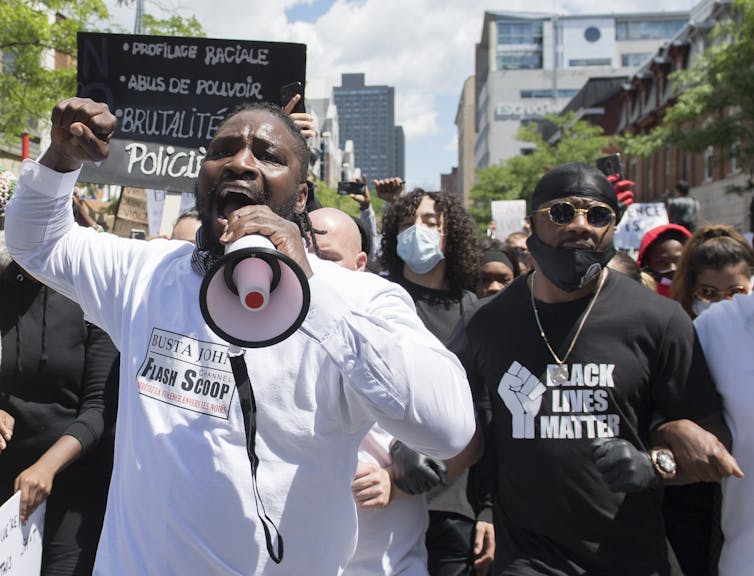
In 2021 and 2022, the Hidden Racial Profiling Project (HRPP) at Western University’s Faculty of Law helped the Toronto Star identify more than 600 court decisions from the past decade that found Canadian police violated the Charter of Rights and Freedoms when dealing with the public.
Violations included excessive force, unreasonable searches and not being told of your right to a lawyer without delay. The decisions reveal pervasive and systemic failures by many police services with respect to our fundamental rights. Few police services told the Star whether they were aware of the cases. Most refused to say.
The 600 cases are a huge underestimation of just how frequently police are violating Canadians’ Charter rights. They do not include cases where evidence that was gathered in violation of the Charter was not excluded, the proceedings were not stopped by judges or sentences were not reduced.
They also do not include incidents that we will never see in criminal case law — Charter-infringing conduct, like arbitrary detentions, unreasonable searches and racial profiling, that do not result in charges or cases that were withdrawn by the Crown.
Race is often not mentioned in criminal cases when judges found officers violated the Charter rights of accused. Our project seeks to identify the race of victims in Charter-violating cases and expose racial profiling.

Identifying Charter violations
Since the Toronto Star series was published, our project has completed its case-law research and flagged problematic trends. We are now beginning the process of identifying the race of victims of Charter violations.
Police violations of the Charter matter. They negatively impact the physical and mental health of victims and undermine public trust and safety. They discourage co-operation with police, and we know that relationships between police and Indigenous and Black communities are already strained because of systemic racism in policing. Charter violations can also result in evidence being excluded from trials and in the accused walking free.
Police forces should be told when courts find that officers violate the Charter, but there is no need to wait for governments to set up formal notification systems. Charter violations can be found with a few keystrokes and some sifting and sorting.
The HRPP searched for cases that were decided between 2015 and 2019 and involved the 10 largest city police services in Canada. We were struck by the sheer volume of cases with Charter violations. We felt there was a public interest in getting this information into the public eye so we provided our case-law research to the Star, which did a broader search.
If the HRPP could find these cases, police services can too. They have the resources and know-how to find them themselves. And the decisions must lead to police transparency and accountability.
Large police services, like those in Montréal, Ottawa and Calgary, have budgets in the hundreds of millions, or, in the case of Toronto, the RCMP and the Ontario Provincial Police, over a billion. Smaller services, like Victoria and Fredericton, have budgets in the tens of millions. And all of them have lawyers.

Police transparency and accountability
Court decisions with Charter violations should be part of an early intervention system to alert supervisors and police leadership about problematic officers, units and divisions.
Canadian police services would not be the first to do so. Cases where evidence was excluded due to constitutional violations are part of early intervention systems for the Ferguson, Mo. and Baltimore, Md. police forces.
Court decisions with Charter violations should also trigger investigations into officer misconduct and lead to training or discipline where appropriate. Where there are systemic issues, policies and training should be changed — not in secret, but publicly, and not in a way that’s colour-blind, but through an anti-racism lens.
One of the cases the HRRP found was R v. Gonzales. In 2009, a York Regional Police officer pulled over two Hispanic men in a rental van. The officer was investigating break-and-enters in the area, but had no reason to link the men or the van to the crimes. The officer also had no suspect description. Five days earlier, the officer had seen the van in the same area and its occupants enter a home. The officer even thought that one of the men may have lived there.
The officer smelled marijuana coming from the van and called for backup. Searches of the van and home uncovered a gun, ammunition, hundreds of pounds of marijuana and more than $100,000 in cash. The men were arrested.
In a 2017 appeal, Ontario’s highest court concluded the traffic stop was an arbitrary detention and one of the men was unlawfully strip-searched at the station — both violations of the Charter.
Consequently, the evidence police found was tossed out. One of the men was acquitted and would not serve the original five-year prison term.
The judge found the officer’s misconduct was not an isolated incident but part of a “pattern of abuse.” The court stated “evidence emerged from the officers at trial that this stop was part of a larger pattern of pulling over ‘suspicious’ persons and asking them what they were doing in the neighbourhood.”
Worse still, the same pattern was noted in two other cases involving the same police service the next year: R v. Bhagiratti and R v. Noseworthy.
York Regional Police appear to be aware of the R v. Gonzales and R v. Bhagiratti decisions and respect them. But what steps did the York Regional Police or its board take to address the “pattern of abuse,” including any disproportionate impact on Indigenous, Black or other racialized people? Were the officers investigated, disciplined or retrained?
Were policies or training reviewed or changed? It may take legislative change for there to be transparency about individual officer discipline, but these other questions need to be asked and answered publicly.
If police are serious about respecting our fundamental rights and ensuring public safety, they should take action. And we deserve to see it. Justice depends on it.
Sunil Gurmukh received funding from the Law Foundation of Ontario via Western University's Faculty of Law for the Hidden Racial Profiling Project, which he is leading. His views do not represent the Ontario Human Rights Commission or Ontario Public Service.
This article was originally published on The Conversation. Read the original article.







